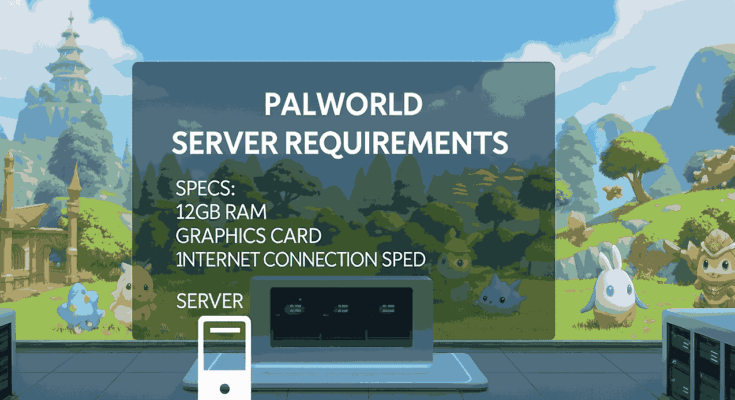✅ Quick Answer: What Are the Palworld Server Requirements
To run a Palworld server smoothly, you need a high-performance CPU (3.5 GHz or faster), 8–16 GB of RAM, and SSD or NVMe storage. Multiplayer servers with active Pals and base automation require more resources, especially for 10+ players. Apex Hosting provides optimized servers with modern CPUs, scalable RAM, NVMe SSDs, and global low-latency locations, making it the best choice for hosting Palworld.
👉 Best Palworld Server Hosting Providers in 2025
CPU Requirements for Palworld Servers
When it comes to hosting a Palworld server, the CPU is your first line of defense against lag and crashes. Palworld isn’t just about blocks and bullets; it runs real-time AI for dozens of creatures (Pals), environmental simulations, player actions, factory automation, and potentially modded mechanics. That puts your CPU under constant load.
How Palworld Uses CPU Power
Creature AI: Each Pal has unique behaviors, tasks, and battle logic
Combat and physics: Bullets, damage calculations, and animations
Multiplayer sync: Tracking positions, events, and world state for each player
Base automation: Crafting stations, power grids, and production loops
These systems rely heavily on your CPU’s ability to process thousands of real-time events per second, especially when multiple players are active across different zones.
Minimum vs Recommended CPU Specs
| Server Type | Recommended CPU | Use Case |
|---|
| Solo or LAN server | Dual-core @ 3.0 GHz | Minimal AI load, local access |
| 2–8 players (small group) | Quad-core @ 3.5 GHz | AI + moderate multiplayer sync |
| 8–20 players (PvE/PvP) | 6-core @ 3.8+ GHz | High AI + world simulation |
| 20+ players/modded | 8-core+ @ 4.0+ GHz | Max AI load, bosses, automation |
⚠️ Palworld benefits from strong single-thread performance, but it also utilizes multi-threading more than older survival games. Choose a modern CPU like an Intel i7+ or AMD Ryzen 7/9.
RAM Requirements for Palworld Servers
While the CPU processes your server’s logic, RAM handles the memory workload, and Palworld has plenty of it. From tracking every active Pal, structure, and item to loading terrain and managing player inventory, your server’s RAM must be ready to juggle it all in real time.
Too little RAM? Expect slowdowns, world save errors, and even server crashes when things get busy.
What Consumes RAM in Palworld?
Loaded world regions (chunks)
Pal AI behavior data
Player-built bases and factories
Item storage, inventory systems
Mod data (if supported in the future)
The more players and active Pals on your server, the more memory you’ll need.
Recommended RAM by Server Size
| Server Size | Player Count | Recommended RAM |
|---|
| Solo / LAN | 1 | 4 GB |
| Small private server | 2–8 | 6–8 GB |
| Medium PvE/PvP world | 8–20 | 10–12 GB |
| Large or modded server | 20+ | 16–32 GB |
🧠 Tip: Always leave extra RAM headroom for autosaves, AI spikes, and unexpected memory spikes, especially during boss fights or raid events.
Avoid RAM Bottlenecks
Even if your CPU is strong, insufficient RAM can cause:
Delayed entity updates (e.g., Pals freezing mid-task)
Long world save/load times
Random crashes under high player load
Make sure your RAM allocation scales with your server’s activity.
Storage Requirements for Palworld Servers
Storage might seem like an afterthought when setting up a game server, but in Palworld, it plays a critical role in performance. From frequent world saves to loading high-resolution assets, fast and reliable storage ensures your server runs smoothly, especially during high activity or auto-backup events.
What Affects Storage Usage in Palworld?
World size: As players explore and build, new chunks are generated and saved
Bases & structures: Large, complex bases consume more disk space over time
Pals: Each creature’s status, position, and stats must be persistently saved
Crafted items & inventories: Every item placement adds to saved data
Backups: Daily or hourly backups can quickly eat up space
Recommended Storage Specs
| Server Type | Storage Type | Recommended Capacity |
|---|
| Solo / Small Group | SSD | 10–20 GB |
| Medium Multiplayer | SSD | 30–50 GB |
| Public / Long-term World | NVMe SSD | 50–100+ GB |
📁 Tip: Always plan for future growth. Backups alone can double your storage needs within a few weeks.
Network and Bandwidth Considerations
A powerful CPU and fast storage are important, but without a stable, high-speed network connection, your Palworld server will still lag, desync, or drop players. Palworld is an always-simulating multiplayer game, which means your server constantly sends and receives real-time data between players, creatures, and the world.
Why Network Speed Matters in Palworld
Your server needs to handle:
Player movement and combat sync
Pal AI and base automation updates
Building placement and terrain changes
Resource collection, trades, and raids
The more players connected, the more bandwidth your server needs to maintain smooth and responsive gameplay.
Recommended Upload Speeds
| Player Count | Minimum Upload Speed | Recommended Upload Speed |
|---|
| Solo / LAN | 1 Mbps | 2 Mbps |
| 2–8 players | 5 Mbps | 10 Mbps |
| 8–20 players | 15 Mbps | 20+ Mbps |
| 20+ players | 25+ Mbps | 30–50+ Mbps |
📶 Upload speed is more important than download speed for hosting. Lag usually comes from upload bottlenecks on self-hosted servers.
Palworld Server Requirements at a Glance
Here’s a quick-reference guide to help you match your Palworld server’s hardware and bandwidth requirements to your use case. Whether you’re playing solo or managing a 30-player PvP world, this table makes it easy to plan and scale.
| Server Type | Player Count | CPU (Min/Rec.) | RAM | Storage | Upload Speed | Recommended Apex Plan |
|---|
| Solo / LAN | 1 | 2-core @ 3.0 GHz | 4 GB | 10 GB SSD | 1–2 Mbps | Apex 2–4 GB Plan |
| Small Private Server | 2–8 | 4-core @ 3.5 GHz | 6–8 GB | 20–30 GB SSD | 10 Mbps | Apex 4–8 GB Plan |
| Medium PvE Server | 8–20 | 6-core @ 3.8+ GHz | 10–12 GB | 40–60 GB SSD | 20 Mbps | Apex 8–12 GB Plan |
| Modded / Public Server | 20+ | 8-core @ 4.0+ GHz | 16–32 GB | 60–100+ GB NVMe SSD | 30–50+ Mbps | Apex 16–32 GB Plan or Custom Setup |
✅ Tip: For future-proof hosting, always leave room to scale CPU, RAM, and storage, especially if you expect your player base or world size to grow.
Conclusion: Host Smarter, Play Smoother
Palworld brings together the thrill of survival, the fun of creature collecting, and the chaos of multiplayer exploration—all in a massive open world. But to truly enjoy everything the game has to offer, especially with friends or a community, you need more than just a game key—you need the right server setup.
From high single-core CPU performance to generous RAM and fast NVMe SSDs, Palworld servers demand modern, well-optimized hardware. Whether you’re playing solo, building with friends, or hosting an active PvP server, your hardware choices will make or break the experience.
And while self-hosting might work for a test world, serious players know that performance, uptime, and support are non-negotiable.
🎮 Ready to launch your Palworld adventure? Choose Apex Hosting and give your server the performance it deserves, from day one.
FAQs: Palworld Dedicated Server Requirements
1. Can I host a Palworld server on my own PC?
Yes, but it depends on your hardware. Hosting locally is okay for solo or small-group play, but anything beyond that may cause lag or crashes—especially with creature AI and automation systems. For 24/7 stability and low-latency multiplayer, using a provider like Apex Hosting is strongly recommended.
2. Is SSD storage required for Palworld?
Yes. Due to the large world size, frequent autosaves, and creature data, using NVMe SSDs ensures fast world loading and smooth performance. Avoid HDDs, they cause lag. Apex Hosting uses only NVMe SSDs on all plans.
3. Do I need fast internet to host a Palworld server?
If you're self-hosting, you’ll need a strong upload speed (at least 10–20 Mbps for multiplayer). Otherwise, players will experience lag or disconnections.




